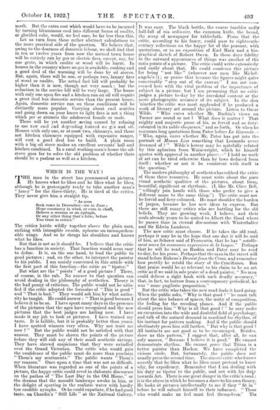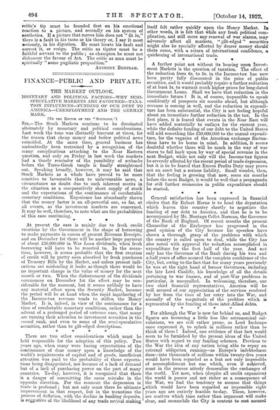WHICH IS THE WAY ? T HE man in the street
has pronounced on pictures. He knows what he likes and he likes what he likes, although he is grotesquely ready to take another man's " fancy " for the three-thirty. He is tired of the critics. They never give him a straight tip.
" As soon Seek roses in December—ice in June ; Hope constancy in wind, or corn in chaff, Believe a woman or an epitaph, Or any other thing that's false, before You trust in critics."
The critics battle wildly together above the plain man, striking with intangible swords, upborne on incomprehen- sible wings. And so he shrugs his shoulders and knows what he likes.
But that is not as it should be. I believe that the critic has a function in society. That function would seem easy to define. It is, on the one hand, to lead the public to good pictures ; and, on the other, to interpret the painter to his public. I am mainly concerned in this article with the first part of this function—the critic as " tipster." But what are the " points " of a good picture ? There, of course, is the rub. No answer to that question can avoid dealing in the philosophy of aesthetics. Theory is the bad penny of criticism. The public would not be satis- fied if the critic adopted the formulae of " This is good " and " That is bad." They would ask him by what autho- rity he taught. He could answer : " That is good because I believe it to be so. I have spent many days in the presence of the pictures that the ages have recognized and the new pictures that the best judges are hailing now. I have made it my job to look at pictures. I have trained my taste. It is fallible, but it is probably better than yours. I have spotted winners very often. Why not trust me now ? " But the public would not be satisfied with that answer. They must be shown the points of the picture before they will risk any of their small aesthetic savings. They have shrewd suspicions that they were swindled over the Grand Victorian. The critic who would gain the confidence of the public must do more than proclaim ." Them's my sentiments." The public wants " Them's my reasons." Once upon a time that was not so difficult. When literature was regarded as one of the points of a picture? the happy critic could revel in elaborate discourses on the pathos of " The Last Day in the Old Home," or .the dreams that the moonlit landscape awoke in him, or the delight of sporting in the realistic water with hardly less credible nymphs. Or he could expatiate, if he had good taste, on Chardin's " Still Life " at the National Gallery. It was easy. The black bottle, the coarse tumbler sadly half-full of tin ordinaire, the common knife, the bread, the scrap of newspaper for tablecloth. From that the critic, according to his fancy, could pass to eighteenth- century reflections on the happy lot of the peasant, with quotations, or to an exposition of Karl Marx and a bio- graphical sketch of Robert Owen. In those days fidelity to the outward appearances of things was another of the main points of a picture. The critic could write extensively and easily about that. Ho could condemn this picture for being " not like " (whoever saw men like Michel- angelo's ?) ; or praise that because the figures might quite conceivably " step out of the canvas." I am not con- cerned here with the vital problem of the importance of subject in a picture, but I am presuming that no critic judges a picture to-day by the anecdotal content or the mere photographic accuracy of its subject. In the dim 'nineties the critic was most applauded if he produced a work of literary art around the picture. Listen to Oscar Wilde. " Who cares whether Mr. Ruskin's views on Turner are sound or not ? What does it matter ? That mighty and majestic prose of his, so fervid and so fiery- coloured in its noble eloquence," and so forth. Or when he murmurs long quotations from Pater before La Gioconda- " Who, again, cares whether Mr. Pater has put into the portrait of Manna Lisa something that Leonardo never dreamed of ? " Wilde's heresy may be spitefully refuted by this aphorism from Waincwright, which he himself quotes with approval in another place :—" I hold no work of art can be tried otherwise than by laws deduced from itself : whether or not it be consistent with itself is the question."
The modern philosophy of aesthetics has robbed the critic of these three resources. He must write about the pure visual aesthetic qualities of the pictures, about form, beautiful, significant or rhythmic. (I, like Mr. Clive Bell, " willingly join hands with those who prefer to give a different name to the same thing.") The critic must not be fervid and fiery-coloured. He must shoulder the burden of jargon, because he has new ideas to express. But there are still many critics who are battling for the old beliefs. They are growing weak, I believe, and their souls already yearn to be united to Albert the Good where he passes time in eternal discussions with Winterhalter and Sir Edwin Landseer.
The new critic must choose. If he takes the old road, perhaps it may be in the hope that one day it will be said of him, as Scherer said of Fromentin, that he has " notable- ment accru les ressources expressives de la langue." Perhaps that he will be read, as Ruskin and Pater may be read to-day, for his prose. Perhaps that the man in the street will stand before Rubens's Descent from the Cross, and remember how prettily he retold the story of the Crucifixion. But that praise would be as relevant to his claim to be an art critic as if we said in sole praise of a dead painter, No matt could deliver a right hook with such deadly accuracy," that, in fact, to borrow from a contemporary periodical, ho was " some pugilistic proposition."
But the critic who takes the new road finds it hard going. When the public asks, " Why is that good ? " he must talk about the nice balance of spaces, the unity of composition, the feeling for the receding planes. And if the public should press him " Why is all that good ? " he may make an excursion into the wide and doubtful field of psychology, and talk of the natural demand in mankind for rhythm, of his instinct for pattern making. And if the public should obstinately press him still further, " But why is that good ? All instincts are not good or to be encouraged. Besides, show us this pattern," I suggest that, after all, he can only answer, " Because I believe it is good." He cannot demonstrate rhythm. He cannot prove that Titian is a better painter than Hacker. We have completed the vicious circle. But, fortunately, the public does not usually press the second time. The sincere critic who knows secretly that he likes what he likes must pretend to know why, for expediency. Remember that I am dealing with his duty as tipster to the public, and not with his duty towards Art. There is one great danger in the critic's road it is the abyss in which he becomes a slave to his own theory. He looks at pictures intellectually to see if they " fit in " before he will submit himself to their influence. " Those who would make us feel must feel. thempelves." The critic's tip must be founded first on his emotional reaction to a picture, and secondly on his system of aesthetics. If a picture that moves him does not " fit in," there is a fault in his taste or his theory or, I say it most seriously, in his digestion. He must locate his fault and correct it, or resign. The critic as tipster must be a faithful servant to the public ; as champion he must not dishonour the favour of Art. The critic as man must be spiritually " some pugilistic proposition."
ANTHONY BERTRAM.



































 Previous page
Previous page